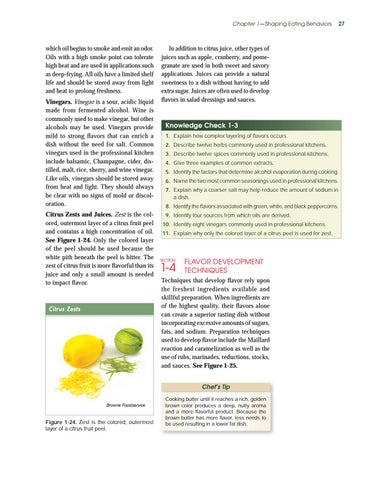Chapter 1 — Shaping Eating Behaviors
which oil begins to smoke and emit an odor. Oils with a high smoke point can tolerate high heat and are used in applications such as deep-frying. All oils have a limited shelf life and should be stored away from light and heat to prolong freshness. Vinegars. Vinegar is a sour, acidic liquid made from fermented alcohol. Wine is commonly used to make vinegar, but other alcohols may be used. Vinegars provide mild to strong flavors that can enrich a dish without the need for salt. Common vinegars used in the professional kitchen include balsamic, Champagne, cider, distilled, malt, rice, sherry, and wine vinegar. Like oils, vinegars should be stored away from heat and light. They should always be clear with no signs of mold or discoloration. Citrus Zests and Juices. Zest is the colored, outermost layer of a citrus fruit peel and contains a high concentration of oil. See Figure 1-24. Only the colored layer of the peel should be used because the white pith beneath the peel is bitter. The zest of citrus fruit is more flavorful than its juice and only a small amount is needed to impact flavor.
Citrus Zests
In addition to citrus juice, other types of juices such as apple, cranberry, and pomegranate are used in both sweet and savory applications. Juices can provide a natural sweetness to a dish without having to add extra sugar. Juices are often used to develop flavors in salad dressings and sauces.
Knowledge Check 1-3 1. Explain how complex layering of flavors occurs. 2. Describe twelve herbs commonly used in professional kitchens. 3. Describe twelve spices commonly used in professional kitchens. 4. Give three examples of common extracts. 5. Identify the factors that determine alcohol evaporation during cooking. 6. Name the two most common seasonings used in professional kitchens. 7. Explain why a coarser salt may help reduce the amount of sodium in a dish. 8. Identify the flavors associated with green, white, and black peppercorns. 9. Identify four sources from which oils are derived. 10. Identify eight vinegars commonly used in professional kitchens. 11. Explain why only the colored layer of a citrus peel is used for zest.
SECTION
1-4
FLAVOR DEVELOPMENT TECHNIQUES
Techniques that develop flavor rely upon the freshest ingredients available and skillful preparation. When ingredients are of the highest quality, their flavors alone can create a superior tasting dish without incorporating excessive amounts of sugars, fats, and sodium. Preparation techniques used to develop flavor include the Maillard reaction and caramelization as well as the use of rubs, marinades, reductions, stocks, and sauces. See Figure 1-25. Chef’s Tip
Browne Foodservice
Figure 1-24. Zest is the colored, outermost layer of a citrus fruit peel.
27
Cooking butter until it reaches a rich, golden brown color produces a deep, nutty aroma and a more flavorful product. Because the brown butter has more flavor, less needs to be used resulting in a lower fat dish.
